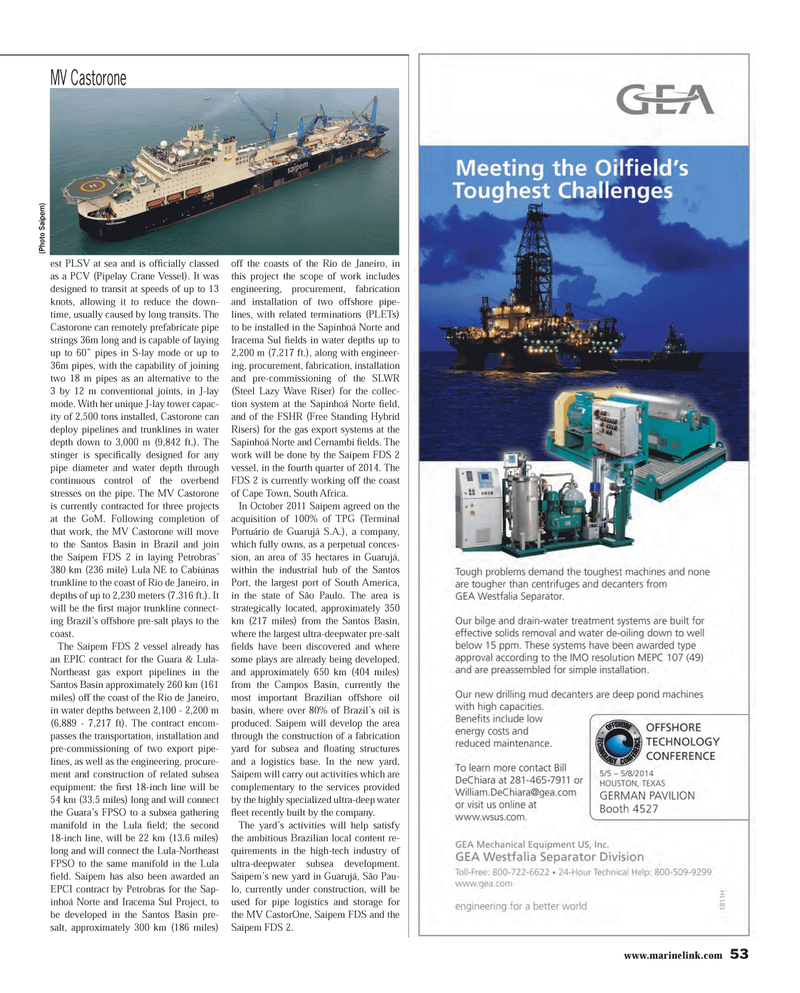
Page 53: of Maritime Reporter Magazine (April 2014)
Offshore Edition
Read this page in Pdf, Flash or Html5 edition of April 2014 Maritime Reporter Magazine
www.marinelink.com 53est PLSV at sea and is of Þ cially classed as a PCV (Pipelay Crane Vessel). It was designed to transit at speeds of up to 13 knots, allowing it to reduce the down-time, usually caused by long transits. The Castorone can remotely prefabricate pipe strings 36m long and is capable of laying up to 60? pipes in S-lay mode or up to 36m pipes, with the capability of joining two 18 m pipes as an alternative to the 3 by 12 m conventional joints, in J-lay mode. With her unique J-lay tower capac- ity of 2,500 tons installed, Castorone can deploy pipelines and trunklines in water depth down to 3,000 m (9,842 ft.). The stinger is speciÞ cally designed for any pipe diameter and water depth through continuous control of the overbend stresses on the pipe. The MV Castorone is currently contracted for three projects at the GoM. Following completion of that work, the MV Castorone will move to the Santos Basin in Brazil and join the Saipem FDS 2 in laying Petrobras? 380 km (236 mile) Lula NE to Cabiúnas trunkline to the coast of Rio de Janeiro, in depths of up to 2,230 meters (7.316 ft.). It will be the Þ rst major trunkline connect- ing Brazil?s offshore pre-salt plays to the coast. The Saipem FDS 2 vessel already has an EPIC contract for the Guara & Lula-Northeast gas export pipelines in the Santos Basin approximately 260 km (161 miles) off the coast of the Rio de Janeiro, in water depths between 2,100 - 2,200 m (6,889 - 7,217 ft). The contract encom- passes the transportation, installation and pre-commissioning of two export pipe-lines, as well as the engineering, procure-ment and construction of related subsea equipment: the Þ rst 18-inch line will be 54 km (33.5 miles) long and will connect the Guara?s FPSO to a subsea gathering manifold in the Lula Þ eld; the second 18-inch line, will be 22 km (13.6 miles) long and will connect the Lula-Northeast FPSO to the same manifold in the Lula Þ eld. Saipem has also been awarded an EPCI contract by Petrobras for the Sap-inhoá Norte and Iracema Sul Project, to be developed in the Santos Basin pre-salt, approximately 300 km (186 miles) off the coasts of the Rio de Janeiro, in this project the scope of work includes engineering, procurement, fabrication and installation of two offshore pipe- lines, with related terminations (PLETs) to be installed in the Sapinhoá Norte and Iracema Sul Þ elds in water depths up to 2,200 m (7,217 ft.), along with engineer- ing, procurement, fabrication, installation and pre-commissioning of the SLWR (Steel Lazy Wave Riser) for the collec- tion system at the Sapinhoá Norte Þ eld, and of the FSHR (Free Standing Hybrid Risers) for the gas export systems at the Sapinhoá Norte and Cernambi Þ elds. The work will be done by the Saipem FDS 2 vessel, in the fourth quarter of 2014. The FDS 2 is currently working off the coast of Cape Town, South Africa. In October 2011 Saipem agreed on the acquisition of 100% of TPG (Terminal Portuário de Guarujá S.A.), a company, which fully owns, as a perpetual conces-sion, an area of 35 hectares in Guarujá, within the industrial hub of the Santos Port, the largest port of South America, in the state of São Paulo. The area is strategically located, approximately 350 km (217 miles) from the Santos Basin, where the largest ultra-deepwater pre-salt Þ elds have been discovered and where some plays are already being developed, and approximately 650 km (404 miles) from the Campos Basin, currently the most important Brazilian offshore oil basin, where over 80% of Brazil?s oil is produced. Saipem will develop the area through the construction of a fabrication yard for subsea and ß oating structures and a logistics base. In the new yard, Saipem will carry out activities which are complementary to the services provided by the highly specialized ultra-deep water ß eet recently built by the company. The yard?s activities will help satisfy the ambitious Brazilian local content re-quirements in the high-tech industry of ultra-deepwater subsea development. Saipem?s new yard in Guarujá, São Pau- lo, currently under construction, will be used for pipe logistics and storage for the MV CastorOne, Saipem FDS and the Saipem FDS 2.MV Castorone (Photo Saipem)MR #4 (50-55).indd 53MR #4 (50-55).indd 534/5/2014 3:24:03 PM4/5/2014 3:24:03 PM

 52
52

 54
54
